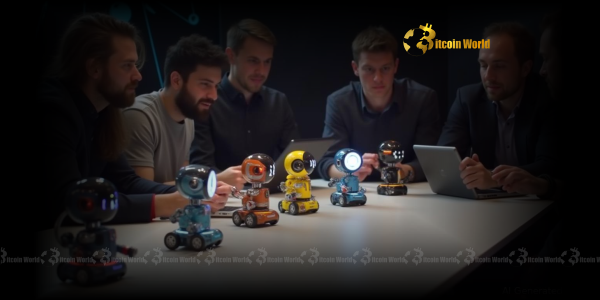BitcoinWorld

Revolutionary AI Robots: Hugging Face’s Reachy Mini Achieves Surprising Success
In the rapidly evolving world of artificial intelligence and robotics, where every new device promises groundbreaking functionality, a peculiar yet captivating innovation has emerged from Hugging Face. Meet the Reachy Mini, a new breed of AI robots that, much like the iconic sitcom ‘Seinfeld,’ seems to be about nothing in particular, yet manages to be utterly compelling. For those in the cryptocurrency and tech space, understanding the underlying principles and market reception of such novel hardware can offer valuable insights into future decentralization and innovation trends.
The Charm of Reachy Mini: Hugging Face’s Unconventional Approach
Hugging Face, a name synonymous with open-source AI models and tools, has taken an unexpected leap into physical products with the launch of its programmable Reachy Mini bots. These aren’t your typical sophisticated industrial robots. Instead, they are open-source, powered by Raspberry Pi, and adorned with charmingly cartoonish antennae and big googly eyes. Their initial appeal lies precisely in what they don’t do out of the box. As Bitcoin World’s Equity podcast hosts Kirsten Korosec, Max Zeff, and Anthony Ha discussed, the Reachy Mini embodies the ‘Seinfeld of AI hardware’ – doing nothing in particular, yet captivating an audience.
This unconventional design choice, combined with their open-source nature, suggests a deliberate strategy. Instead of a highly specialized tool, Hugging Face is offering a versatile platform. This approach encourages creativity and community-driven development, allowing users to program the robots for diverse tasks. This democratizes access to robotics, making it less about proprietary systems and more about collaborative innovation.
The Power of Open Source AI in Physical Products
The decision by Hugging Face to make the Reachy Mini bots open source is a significant one. In an era where many tech companies guard their intellectual property fiercely, the open-source model fosters transparency, collaboration, and rapid iteration. For developers, this means the freedom to inspect, modify, and distribute the robot’s software and potentially hardware designs, leading to a vibrant ecosystem of custom applications and enhancements. This aligns with the ethos often seen in the crypto world, where open protocols and community governance drive innovation.
Key aspects of the Reachy Mini’s open-source design:
- Accessibility: Lowering the barrier to entry for robotics development, allowing hobbyists, educators, and small businesses to experiment.
- Community-Driven Innovation: Encouraging a global community of developers to build new functionalities and share their creations.
- Transparency: Users can understand exactly how the robot works, fostering trust and enabling greater customization.
- Cost-Effectiveness: Leveraging readily available components like Raspberry Pi helps keep the hardware affordable, promoting wider adoption.
This commitment to open source not only sets the Reachy Mini apart but also positions it as a potential catalyst for a new wave of accessible robotics applications.
Reachy Mini’s Surprising Market Debut: A Glimpse into AI Hardware Demand
Despite their minimalist initial functionality, the Reachy Mini bots pulled in a surprising $500,000 in sales within their first 24 hours. This impressive figure underscores a significant market appetite for accessible, programmable AI hardware, even if its immediate purpose isn’t clearly defined. It suggests that consumers and developers are keen to get their hands on platforms that offer flexibility and the potential for future innovation, rather than just pre-packaged solutions.
The rapid sales success could be attributed to several factors:
- Hugging Face’s Brand Reputation: Their strong standing in the AI community likely generated significant pre-launch interest.
- Novelty and Charm: The robot’s unique, approachable design makes it appealing beyond just technical enthusiasts.
- Developer Interest: The open-source nature attracts a strong developer community eager to build and experiment.
- The ‘Seinfeld’ Factor: The very concept of a robot that ‘does nothing’ sparks curiosity and invites users to define its purpose.
This initial success provides valuable data points for companies exploring the monetization of physical products in the AI hardware space, particularly those with a strong software or platform background.
Broader Tech Insights from Bitcoin World’s Equity Podcast
The Equity podcast episode also delved into other significant tech news, offering a wider perspective on the current landscape beyond just AI robots. These discussions highlight the dynamic and often unpredictable nature of the tech industry:
- Grok’s Wild Week and Linda Yaccarino’s Exit from X: The rapid developments surrounding Elon Musk’s AI venture, Grok, and the abrupt departure of X’s CEO, Linda Yaccarino, underscore the volatile nature of leadership and product strategy in high-profile tech companies.
- Rivian’s Micromobility Spinoff, Also: The news of Rivian’s spinoff, Also, securing an additional $200 million for e-bikes, even without a launched product, highlights the continued investor confidence in sustainable transportation and micromobility solutions. This shows that visionary ideas, even pre-product, can attract substantial funding in certain sectors.
- LangChain’s Billion-Dollar Valuation: LangChain reportedly closing a new funding round that would push its valuation to $1 billion, partly due to a pivot towards monetizing its developer tools, signifies the immense value being placed on foundational AI development frameworks and the shift towards monetizing developer-centric platforms.
These diverse topics from the podcast paint a picture of an industry in constant flux, driven by innovation, strategic pivots, and significant investment, all of which ultimately impact the broader digital economy, including the crypto market.
The Future is Open: The Potential of Programmable AI Robots
The emergence of devices like the Reachy Mini signals a fascinating direction for the future of AI Robots. Rather than being confined to industrial settings or highly specialized tasks, these accessible, programmable platforms could foster a new wave of personal and educational robotics. Imagine classrooms where students learn coding and AI by programming their own googly-eyed bots, or homes where users customize their robots for simple, quirky tasks tailored to their unique needs.
This shift towards more open and user-defined AI hardware could parallel the early days of personal computing, where general-purpose machines became platforms for countless unforeseen applications. Hugging Face’s gamble on the Reachy Mini’s ‘nothing in particular’ nature might just be a brilliant move, inviting the community to fill the void with endless possibilities, thereby unlocking its true, revolutionary potential.
Conclusion: A New Paradigm for AI Hardware
Hugging Face’s Reachy Mini, with its charming simplicity and open-source foundation, represents a compelling new paradigm in AI hardware. Its surprising half-million-dollar sales debut within 24 hours is a testament to the market’s readiness for accessible, programmable AI devices that prioritize flexibility and community-driven innovation over pre-defined functionalities. Much like ‘Seinfeld’ found success in the mundane, the Reachy Mini’s strength lies in its blank canvas, inviting users to imagine and create. As the world of AI continues to evolve, platforms like the Reachy Mini could play a pivotal role in democratizing access to robotics and fostering a new generation of innovators. Keep an eye on these captivating bots; their journey is just beginning.
To learn more about the latest AI hardware trends, explore our article on key developments shaping AI features and institutional adoption.
This post Revolutionary AI Robots: Hugging Face’s Reachy Mini Achieves Surprising Success first appeared on BitcoinWorld and is written by Editorial Team





